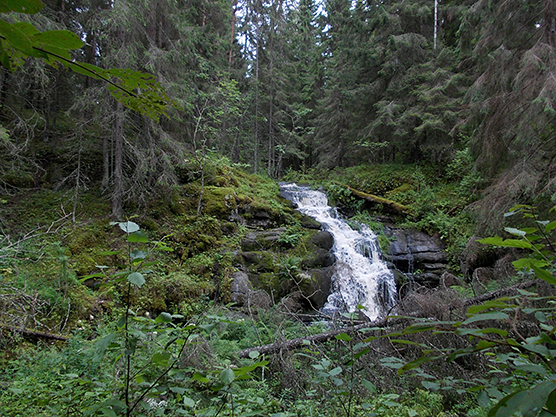Press release 2018-01-15 at 13:49

Waterfall at Rautalahdenniemi at the Lake Ladoga National Park. © Photo: Olli Manninen, the image bank of the Finnish environmental administration
Press release of the Ministry of the Environment, Finnish Environment Institute and Metsähallitus, Parks and Wildlife Finland
At the end of the Year of the Environment 2017 Russia decided to establish a new National Park in the Lake Ladoga archipelago and a new Nature Park on the islands of the Eastern Gulf of Finland and the surrounding waters. Both of these conservation areas have a counterpart on the Finnish side of the border.
The Minister of the Environment, Energy and Housing of Finland Kimmo Tiilikainen is very happy about the decision. “I congratulate Sergey Donskoy, the Minister of Natural Resources and Environment of Russia, for taking decisive action to enforce the decisions on these nature conservation areas, which were long in preparation. Cross-border collaboration is needed to maintain and protect biodiversity. The new conservation areas together with those we had before on both sides of the Finnish-Russian border constitute a fantastic environment. The fact that the areas are close to each other is particularly important for biodiversity and species especially now that they will have to adapt to climate change as well. What the decision also means is new opportunities for promoting sustainable tourism on both sides of the border”, he says.
Unique natural environments and fjord landscapes in the Lake Ladoga National Park
The Lake Ladoga National Park comprises an area of about 122,000 hectares in three municipalities in the Republic of Karelia (Lakhdenpokhya, Sortavala and Pitkyaranta). The National Park is a unique network of long and narrow fjord-like bays and straits and islands. The highest ones, the “reef islands” with steep walls, rise up to 80 metres. There are hundreds of islands, almost a hundred small lakes and nearly 1,000 kilometres of unbuilt shoreline in the area. The nature is similar to that in southwestern Finland, and it also resembles the Norwegian fjord landscapes. There is nothing like it elsewhere in Russia or in the Nordic countries.
The tree stand is highly diverse, including old-growth forests with numerous threatened and rare species. The threatened Lake Ladoga ringed seal has a viable population in the area. The Valaam archipelago protected by an earlier decision is a fine supplement to the area.
Finnish scientists studied the special nature values of the area as early as in the 19th century. After the Second World War the work continued in collaboration with the Karelian Research Institute
Tens of islands in the Gulf of Finland Nature Park
The new Eastern Gulf of Finland Nature Park is located in the municipalities of Vyborg and Kingisepp. The area of more than 14,000 hectares consists of tens of islands and shallow waters less than 10 metres deep surrounding these. The purpose of the park is to protect the natural and cultural values of the islands and surrounding water areas. Recreational use is steered by the principles of sustainable use. The special values of this Nature Park include the abundant avian fauna nesting there and numerous threatened animal and plant species. The area is particularly important as a resting and feeding place for migrating Arctic waders and waterfowl. There is also a Baltic ringed seal population and a more abundant population of grey seal living in the area.
The islands or groups of islands included in the National Park are Pitkäpaasi, Suuri Kalastaja and Halli at the Virolahti border, Severnyi and Južnyi Virgin (Pohjois- and Etelä-Viiri), Maly Tyuters, (Pien Tytärsaari), eastern part of the Bolshoy Tyuters (Tytärsaari), Vigrund and western part of Seskar (Seiskari) and its archipelago. Gogland (Suursaari) and Lavansaari are not included.
Cross-border cooperation
The Parks and Wildlife Finland of Metsähallitus coordinates the cooperation between the parks on the Russian side and their Finnish counterparts. The partner of the Eastern Gulf of Finland Nature Park is the Eastern Gulf of Finland National Park on the Finnish side. The partners of the Lake Ladoga National Park are the Linnansaari and Kolovesi National Parks.
In 1985 Finland and the Soviet Union concluded an agreement on environmental cooperation, renewed as an agreement between Finland and Russia in 1992. In 1997 the Ministry of the Environment of Finland and the Ministry of Environment (later Ministry of Natural Resources and Environment) of Russia together with the neighbouring regions in northwest Russia adopted the Finnish-Russian Development Programme on Sustainable Forest Management and Conservation of Biodiversity in Northwest Russia. The work is coordinated by the Finnish Environment Institute (SYKE) and steered by the Finnish-Russian Working Group on Nature Conservation. Dozens of experts from research institutes, natural conservation organisations and environmental administration of both countries have taken part in this collaboration.
The new Lake Ladoga National Park and Eastern Gulf of Finland Nature Park are part of this cooperation. They are an important addition to the Green Belt of Fennoscandia that is comprised of protected areas near the borders of Finland, Russia and Norway, extending from the Arctic Ocean to the Baltic Sea. The Lake Ladoga National Park supplements the Barents Protected Area Network as well.
At the end of the Year of the Environment 2017 Russia also made a decision on the conservation of the Vasyugan Mire in Southern Siberia. With a surface area of more than 600,000 hectares, it is one of the largest mires in the world.
Photos from the Lake Ladoga National Park for media use (photos: Olli Manninen)
Related sites:
Further information:
Henna Haapala, Ministerial Adviser, Ministry of the Environment, tel. +358 50 364 3894, firstname.lastname@ym.fi
Aimo Saano, Nature Conservation Manager, Metsähallitus, Parks and Wildlife Finland, tel. +358 400 346 467, firstname.lastname@metsa.fi
Rauno Ruuhijärvi, Professor Emeritus, tel. +358 40 764 2377, r.lastname@gmail.com
Tapio Lindholm, Chief Specialist, Finnish Environment Institute, tel. +358 295 251 379, firstname.lastname@ymparisto.fi